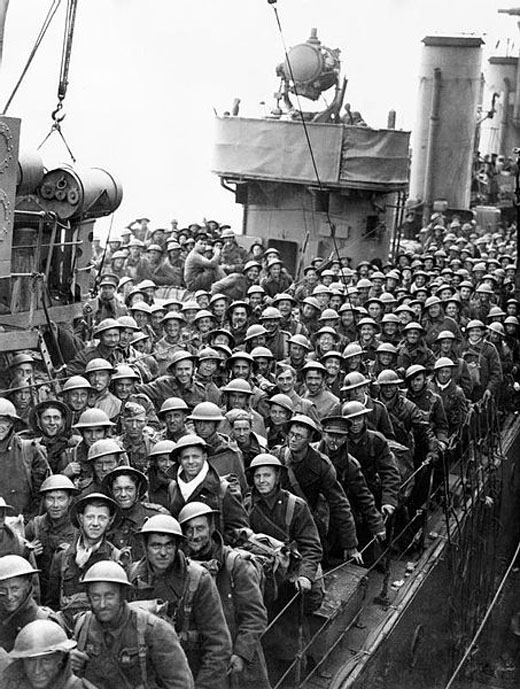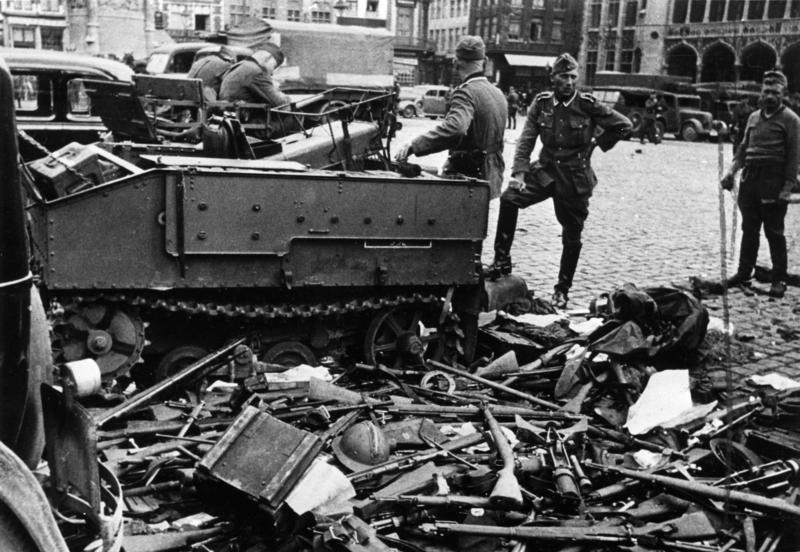Air Operations, Europe
2 elite units of Ju-88 bombers join the assault on Dunkirk. A squadron of RAF Defiant 2-seat fighters claims 37 'kills' over Dunkirk (actual total: 14).
[Atlantic
- The British destroyer is torpedoed and sunk by German motor torpedo boat S-30 close to North Kwinte Buoy. 98 of the crew are lost along with 650 troops being evacuated from Dunkirk. 26 survivors are picked up by British ships in the area.
- The British auxiliary minesweeper Gracie Fields (393t) is sunk by German bombing at Dunkirk 3 miles west of Middelkerk Buoy with loss of 1 crewmen. The British minesweeper Pangbourne picks up the survivors.
- The British auxiliary minesweeper Waverly (537t) is sunk by German bombing at Dunkirk. About 360 passengers and crew are lost. Survivors are picked up by ships in the area.
- The British auxiliary anti-aircraft ship Crested Eagle is sunk by German bombing at Dunkirk. The British minesweeper Pangbourne rescues the survivors.
- The British minesweeping trawler Calvi (363t) is sunk by German bombing in Dunkirk Harbor. The survivors are picked up by the British minesweeping trawler John Cattling.
- Other ships sunk by German bombing at or near Dunkirk include the French steamers Monique Schiaffino (3236t) and Mars (721t), the French auxiliary minesweeper Joseph Marie (41t) and the Belgian tugs Vulcain (200t), Max (177t) and Thames (144t). The French steamer Saint Octave (5099t) is scuttled at Dunkirk. She is later salvaged by German forces and renames Ilse Fritzen for German service.
- The British steamer Clan MacAlister (6787t) is set on fire by German bombing at Dunkirk and abandoned. 18 of her crew are lost. Survivors are picked up by the British destroyer Malcolm and the minesweeper Pangbourne.
- The British steamer Mona's Queen (2756t) sinks on a mine off Dunkirk 1/2 mile from Dunkirk Pier Head with the loss of 26. Her survivors are picked up by the British destroyer Vanquisher.
- Other ships lost in the area include the British steamer Lorena (1578t) by German bombing with the loss of 8 and the British steamer Finella (2376t) by German bombing with the loss of 15.
British Troops at Dover |
 |
Battle of the Atlantic
- The French steamer Saint Claire (3824t) is sunk by German bombing at Tjeldsundet.
- The German auxiliary patrol boat Vp.1109, the trawler Antares, (291t) sinks on a mine in a minefield laid by the British submarine Narwhal.
- U-37 sinks the French steamer Marie Jose (2477t) 40 miles northwest of Vigo near Salvora Island and badly damages the British steamer Telena (7406t). There are 18 dead on the Telena. She is abandoned but is later towed to Spain where it is sold.
- The British destroyer Grafton is torpedoed and badly damaged by U-62 in the North Sea. 15 of the crew are lost. The British destroyer Intrepid takes off the survivors and then scuttles the Grafton by firing 3 shells into her hull. The British steamer Malines also picks up some of the survivors.
Diplomatic Relations
Rumania concludes a trade treaty with Germany exchanging its oil for German arms.
[Norway
British troops are evacuated from Bodo.
[Occupied Holland
Dr Arthur Seyss-Inquart takes office as Reichscommissar for Holland.
[Occupied Belgium
Germans After Belgian Surrender |
 |
Western Front, Dunkirk
The Germans enter Ypres, Ostend and Lille.
Ferry Monta's Queen Sinks |
 |
At Dunkirk, the German forces continue to press all around contracting the perimeter. By the end of the day most of the remaining British troops and a large proportion of the French are inside the final canal positions. The evacuation from Dunkirk and over the beaches goes on. The Luftwaffe increases the strength of its attacks despite the efforts of the RAF to give protection. A further 47,310 men are evacuated but 3 destroyers (Wakeful, Grenade and Grafton by U-62) are sunk and 7 others (6 British and 1 French) damaged. Mackay and Montrose collide and run aground. At least 15 other vessels (8 auxiliary ships and 7 merchant ships) are sunk. The French are now beginning to allow their troops to be evacuated and have sent some ships to assist. Owing to the destroyer losses and the demand for them in other operations the Admiralty decides that the more modern types must be withdrawn.
Hitler meets the commanders of his Army Groups at Cambrai, telling them that he has decided to 'deploy the armored forces immediately for a southward offensive to settle accounts with the French'. The 10 Pzr divs are re-grouped to form 5 Pzr Corps, 3 under the commnad of von Bock, Commander of Army Group B, and 2 under von Rundstedt, who commands Army Group A. Von Bock moves 3 armies, the 4th, 6th and 9th, to the Somme to take up positions beside von Rundstedt's 2nd, 12th and 16th, already on the Aisne and the Ailette.
Gen Weygand, Commander in Chief of the French armed forces, plans to counterattack on the south side of the breach opened by the German pzr divs, where it happens that the bulk of the French forces are concentrated. To face the pzr corps he deploys, on the left, the 10th, 7th and 6th Armies, with the 4th and 2nd in the center and the remainder, the 3rd, 5th and 8th, on the right.
By midnight the greater part of the BEF and almost half the French 1st Army are in sight of the sea in the area of Dunkirk.[MORE]
[